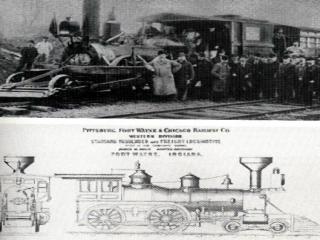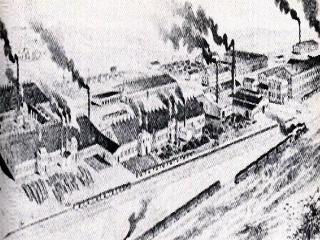

By the early 1850's canal systems throughout the United States were not keeping up with the demand of industry. The Wabash-Erie Canal was no exception. The industrial revolution was on the horizion, and America needed a faster, more practical way to transport goods to the expanding West. The first steam locomotive ironically came way of canal boat. Hoisted off in downtown Fort Wayne, the steam engine was laid on makeshift rails that connected to a larger set of tracks south of town. People from all around came to see the new attraction. The advantage of the railroad projects over the canals were the source of funding. The building of railroads used no government funding since the law now prohibited the leveraging of State bonds for transportation projects. A legacy of the canal projects that literally bankrupted the State, and changed laws forever. Allen County did however become a stockholder in the early developement of the Pittsburgh, Fort wayne, and Chicago Railroad. The railroad was a true free enterprise system. Private funds meant big profits for investors. Coming was the age of the industrial revolution.
With the Arrival of the locomotive and the rail lines from the east,Fort Wayne acted on a great opportunity. The Pittsburgh, Fort Wayne, and Chicago Railroad,later renamed the Pennsylvania Railroad, was the new "boom" for Fort Wayne. The railroad got its start when a man by the man of Jesse L. Williams, a Canal Engineer, came up with the idea to connect Fort Wayne with Chicago via a great road made of rail. Chicago was already becoming a industrial giant, and this railway would open up great financial opportunity for Fort Wayne. This dream would not become reality until 1849 when ground was broken for the Ohio and Pennsylvania Line. The emphasis was then temporarily deverted to this project when on January 15th, 1851 the Board of County Commissioners met to discuss building part of this route through Fort Wayne. The Board, accepting the support of the people, purchased 100,000 dollars stock in the O&P Railroad to begin a section of track between Crestline,Ohio and Fort Wayne. Samuel Hanna was once again a major contributor by being named the County Agent in charge of the stock. Construction began on January 28th, 1952 with the first contract to complete the 131 mile stretch between the two cities. But before much of the work began, the group was in financial trouble. Sam Hanna proceeded to Pittsburgh to pledge his own money to see the project through its completion. While plans to the east were well under way, the citizens of Fort Wayne and Chicago met in Warsaw, Indiana to discuss the western route of the Line. Samuel Hanna was once again chosen to carry this mission forward. By June of 1855 the entire Pennsylvania, Fort Wayne, and Chicago Line was under contract. In that same year the Line was consolidated and renamed the Pittsburgh, Fort Wayne, and Chicago Line. By 1860 the Line was complete and Allen County had sold it's stock back to the Railroad Company. The first railroad through the town of Fort Wayne was complete. In many ways the Country was embracing the rail as it did the towpath. In the few years leading up to the Civil War, the Fort Wayne area was bustling with action. The cities population doubled. Allen County was ranked third in the state for the number of workers employed. Many new enterprises were founded on the basis of construction and repair of these new railroads.
Bass Foundry was formed in the late 1850's was the nation's leader in the producer of locomotive wheels. John Bass quickly became one of the most influencial people of Fort Wayne.Long before Fort Wayne had seen its first locomotive, town visionaries began preparations on what was to become one of the largest industries in our city's history. The land first donated by Samuel Hanna was to become one of the largest locomotive manufacturing and repair centers in the Country.
The Pennsy Shops, named after the Pennsylvania Railroad, became the leader in design, construction, testing, and maintenance of steam engines and Pullman cars. At the turn of the century no less than 200 trains a day arrived and departed from Fort Wayne. In fact, railroad activity was so great that the city's population doubled from 1850 to 1860. Fort Wayne was becoming one of the largest manufacturing centers in the state, and this was only the beginning.
Many stylish passenger cars were being manufactured at this time. The Fort Wayne Silver Palace Cars were manufactered with total convience in mind. The black walnut woodwork and silver-lined arms chairs were trademarks of the Silver Palace Cars.
However, luxury was not the only product coming out of the Pennys shops. "Boone-built" steam engines of Fort Wayne were breaking all speed records on the rails lines. Another locomotive design for speed was the Class X, or Steffin Engine. It is said that on one particular day that one of these engines left Fort Wayne an hour and a half behind schedule, but arrived only a few minutes late. Within the Pennys shops were laborers called the "West Enders" who wore the brim of their striped caps turned up with immense pride at their work. Pushing the envelope of performance kept the shops busy for nearly half a century.
After the turn of the century, the Pennys Shop started to lose their momentum as locomotive production halted shortly after World War One. The Shops continued to overhaul exsisting engines until 1933. By 1953 all production had ceased and the shop was offically abandoned in 1966. The Pennys Shops were indeed the foundation of modern industry in Fort Wayne at the end of the nineteenth century. It laid the ground work for other industries as Fort Wayne's industrial revolution had indeed begun.
By the 1880's, the railroad was here to stay. Fort Wayne was clearly the beacon of rail activity in the midwest. New lines were coming in each year to connect more remote areas of Indiana. One of these new lines would remove a key mode of transportation that had exsisted in Fort Wayne for over 50 years. The canal by this time was in receivership and the State had to sell the right-of-way to recoupe its losses. The suitor was a new railroad company named the New York, Chicago, and St. Louis Railroad, or better known as the Nickel Plate Line. The Canal was filled in and the tracks were laid on its towpath. The raised elevation reduced the amount of work needed to complete the line. In 1882,the railroad was purchased by William H. Vanderbilt for quite a sum. He was quoted as saying," The price we paid for it , it ought to be nickel-plated". Thus the birth of the Nickel Plate Railroad. This railroad flurished through the turn of the century along with the other lines coming in and out of Fort Wayne. Much later in the 1940's there was concern over the Nickel Plate Railroad cutting off growth to the north side of the city. Long lines created by motorists waiting for the trains to pass congested travel north of Superior Street. The solution was to raise the tracks above the roads to allow an even flow of traffic on Clinton and Lafayette Streets. A railroad truss was installed next to the exsisting line in the 1950's. One interesting discovery was made during the excavation of the area. Well stones were uncovered that were used in the second and third Forts. The well was reconstructed, and stands as the only monument to the last two Forts.










